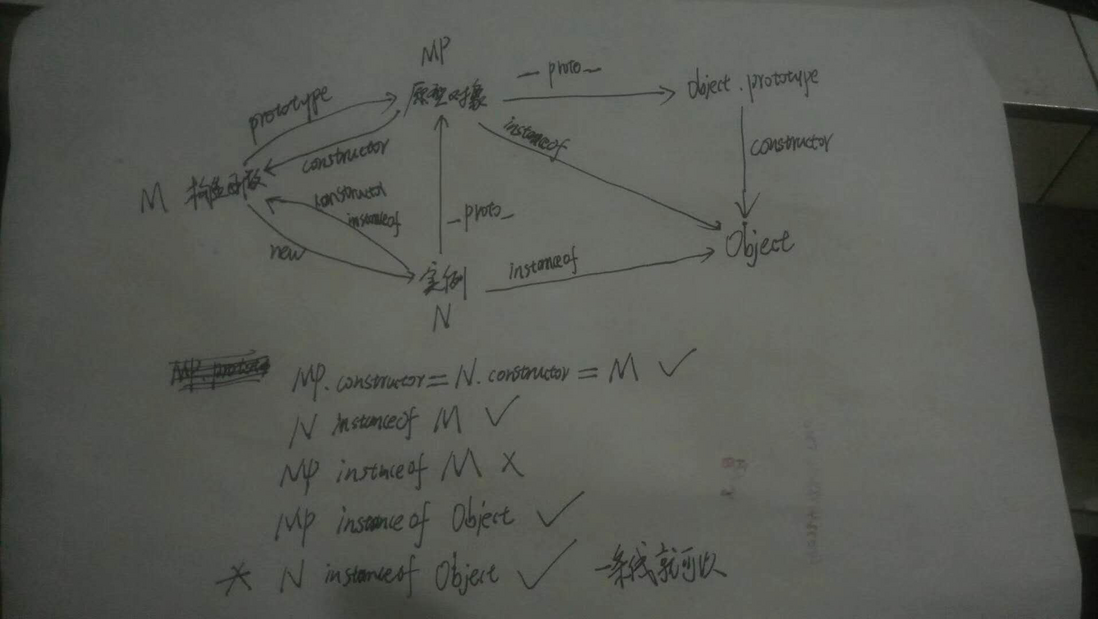一、创建对象的几种方法
// 1、字面量
var o1 = {name:'lihaixing'};
var o11 = new Object({name:'lihaixing'});
// 2、构造函数
var M = function(){this.name='haixing'};
var o2 = new M();
// 3、基于原型
var P = {name:'haixing'};
var o3 = Object.create(P);
var o33 = Object.create(null);二、原型链
var M = function () {
this.name = 'haixing';
// return {}
};
var o2 = new M();
console.log(M.prototype.constructor === M); // true
console.log(M.prototype === o2.__proto__); // true
console.log(M.prototype.__proto__ === Object.prototype); // true
console.log(M.__proto__ === Function.prototype); // true
console.log(Object.prototype.__proto__===null); // true
console.log(o2 instanceof M); // true
console.log(M.prototype instanceof Object); // true
console.log(o2 instanceof Object); // true 只要一条链上就可以函数的原型链
var fn = function(){}
fn instanceof Function // ==> true
fn.constructor===Function // ===> true
Function.prototype instanceof Object // ===> true
Function.prototype.constructor===Object // ===> true
Function.prototype.__proto__ === Object.prototype // ==> true三、继承
1、借助构造函数实现继承
function Parent1 () {
this.name = 'parent1'
this.play = [1, 2, 3]
}
function Child1 () {
Parent1.call(this)
this.type = 'child1'
}缺点:只是将Parents的this指向了Child1的实例,但Parents.prototype中的属性却无法继承下来
// 测试
Parent1.prototype.say=function(){
console.log('Parent1 prototye')
}
var son1 = new Child1();
son1.say(); // Uncaught TypeError: son1.say is not a function2、借助原型链实现继承
function Parent2 () {
this.name = 'parent2'
this.play = [1, 2, 3]
}
function Child2 () {
this.type = 'child2'
}
Child2.prototype = new Parent2();缺点:虽然实现了继承,但是父类实例后的数据却是共用得,导致某个实例改变父亲的数据,其它儿子也就共享了
// 测试
Parent2.prototype.say = function () {
console.log('say')
}
var son2 = new Child2();
var son22 = new Child2();
son2.say(); // say
son2.play.push(4);
console.log(son22.play); // [ 1, 2, 3, 4 ]3、结合以上两种方法实现继承
function Parent3 () {
this.name = 'parent3'
this.play = [1, 2, 3]
}
function Child3 () {
Parent3.call(this)
this.type = 'child3'
}
Child3.prototype = new Parent3()缺点:虽然解决了各自的缺点,但父类执行了两次,并且父类和子类还有相同的属性
4、父类的原型赋值给子类
function Parent4 () {
this.name = 'parent4'
this.play = [1, 2, 3]
}
function Child4 () {
Parent4.call(this)
this.type = 'child3'
}
Child4.prototype = Parent4.prototype 缺点:
- Child4.prototype = Parent4.prototype 使得Child4和Parent4实例得构造器都指向了Parent4, 这明显不是我们想要的,我们希望Child4.prototype.contructor仍然是Child4
有人想到Child4.prototype.constructor = Child4将构造器再改回来,但是这样Parent4.prototype.contructor成了Child4也不妥呀
// 测试 var son4 = new Child4(); // instanceof 取决于由谁创建的,同一条线都可 console.log(son4 instanceof Child4, son4 instanceof Parent4) // true true // 构造器在原型上呢,取决于Child4.prototype.contructor console.log(Child4.prototype.constructor, Parent4.prototype.constructor) // Parent4 Parent45、基于
object.createfunction Parent5 () { this.name = 'parent5' this.play = [1, 2, 3] } function Child5 () { Parent5.call(this) this.type = 'child5' } Child5.prototype = Object.create(Parent5.prototype); // 或者 // Child5.prototype.__proto__ = Parent5.prototype; Child5.prototype.constructor = Child5;最后一个比较完美,不说了
var son5 = new Child5(); console.log(son5 instanceof Child5, son5 instanceof Parent5); // true true console.log(Child5.prototype.constructor,Parent5.prototype.constructor); // Child5 Parent5

**粗体** _斜体_ [链接](http://example.com) `代码` - 列表 > 引用。你还可以使用@来通知其他用户。